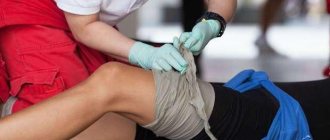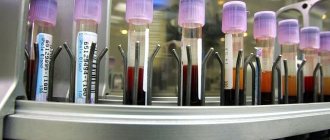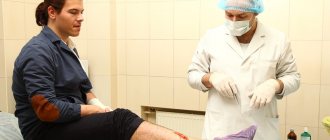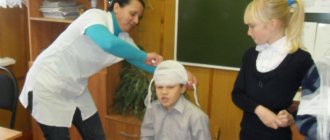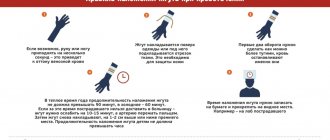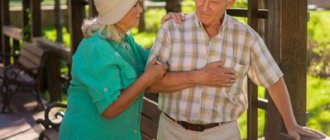Types and signs of external bleeding
Methods to stop bleeding largely depend on their location. Each type has its own external manifestations, to which you need to react in time:
- capillary bleeding - occurs due to damage to small vessels as a result of injury or illness. It manifests itself first in the form of blood dew, and then as a slow flow of blood beyond the skin. This condition can be especially dangerous for people with bleeding disorders;
- internal (parenchymal) bleeding is a rather dangerous condition observed as a result of damage to internal organs that have a large blood supply network (spleen, liver, kidneys);
- arterial bleeding is the result of damage to the aorta, femoral and other arteries and manifests itself in the form of a stream of bright scarlet color with pulsation. The danger of such blood loss is its rapid nature, and therefore the timeliness of assistance in fractions of a second plays a vital role in avoiding death caused by damage to the main artery;
- venous bleeding is the slowest. The blood flows out thick, dark burgundy in color, and clots may form. Bleeding from a damaged vein is dangerous due to the detachment of a blood clot, significant loss of blood, or the entry of air bubbles into a pulmonary vessel.
Main causes and symptoms
Capillaries are the smallest vessels, and in normal cases, their superficial damage to the skin does not pose any danger. Stopping the bleeding occurs on its own and does not require special action. The main sign of damaged capillaries is bright red blood. It flows slowly, there is no pulsation. The blood clotting system will work quickly. The vessel contracts, the blood flow slows down and stops due to the formation of a blood clot from platelets and fibrin fibers. Typically the process lasts up to 5 minutes.
Causes of capillary bleeding:
- abrasions, scratches and cuts;
- burns;
- low platelet concentration (thrombocytopenic purpura);
- decreased coagulability (hemophilia);
- pseudohemophilia - increased vascular permeability, causing spontaneous bleeding;
- oncology;
- purulent inflammation of the skin affecting the capillaries;
- atherosclerosis;
- hormonal imbalance, etc.
External bleeding is noticeable immediately, but internal bleeding (from the vessels of the stomach, uterus, intestines) is determined by the person’s condition. The main signs are weakness and drowsiness for no particular reason, pale skin, severe thirst, rapid pulse, decreased blood pressure. Sometimes the listed symptoms are accompanied by severe shortness of breath, nausea, fainting and dizziness. If first aid is not provided in time, internal capillary bleeding can be fatal.
First aid for venous bleeding
Blood clots that are bleeding from a vein should not be removed, as this may cause even greater blood loss. As first aid, apply a pressure aseptic bandage made of a strong bandage or fabric. If this method is ineffective, it is recommended to use a tourniquet. Under it, in order to avoid unwanted injury to the skin, there should be cotton wool or other soft material and a note with the time of application. The maximum duration of stay of the tourniquet on the victim’s body is 1 hour in the cold season (winter, autumn) and 2 hours in the warm season. If this time frame is exceeded, there is a risk of tissue anesthesia. Instead of a tourniquet, you can use various available materials - tight belts, ties, short sticks with fabric, twisted towels, etc.
Symptoms of bleeding from capillaries
Blood loss from capillaries has the most favorable outcome of all types of bleeding. In the normal state of the body, the bleeding wound surface quickly thromboses, which usually causes a small amount of blood to leak out. Life-threatening conditions may occur under the following conditions:
- large area of skin damage;
- high ambient temperature;
- bleeding disorders (hemorrhagic vasculitis, hemophilia);
- severe diseases (oncology, jaundice, sepsis, scarlet fever);
- increased blood pressure;
- hypovitaminosis (vitamin C, K).
With significant blood loss as a result of concomitant unfavorable factors, the following symptoms appear:
- weakness, drowsiness;
- pale skin, beads of sweat;
- dryness of the oral mucosa;
- increased heart rate, decreased blood pressure;
- dizziness, lightheadedness;
- nausea;
- rapid breathing;
- darkening of the eyes.
With external bleeding, the bleeding area of the body is determined; with internal blood loss, the pathological process can be suspected by the blood content in the secreted fluids. In the case of pulmonary hemorrhage, “rusty” sputum is released, gastrointestinal hemorrhage produces vomit in the form of “coffee grounds”, brown feces, and renal hemorrhage produces red urine.
Arterial bleeding - temporary cessation of arterial bleeding
First aid for bleeding from an artery requires special care, reactivity and speed. Make sure the victim has no fractures and elevate the injured limb. A tissue twist or tourniquet should be placed above the injury site. The time limit is the same as for stopping venous bleeding. Instead of fixing material, you can press the artery with your finger at the point of pulsation above the point of damage. If the ulnar, popliteal, femoral, or brachial arteries are bleeding, you need to fix the limb in the most bent and elevated position.
Application of a tourniquet
Effective first aid for bleeding requires 100% stopping of blood flow from the damaged blood vessel. If dressings, fabric twists and other available means are powerless in this matter, you should use a tourniquet. But remember that this is a last resort, since in most cases it leads to damage to tissue and nerve trunks. Application of a tourniquet is also indicated for traumatic amputation and difficulty determining the site of bleeding.
Providing first aid
First aid methods depend on the condition of the body, the nature of the damage, and external conditions. Timely measures taken to stop bleeding prevent the development of undesirable consequences, help maintain hemodynamics (blood movement through the vessels), and maintain the normal functioning of internal organs.
Pressure bandage
The most common method of stopping capillary bleeding is a pressure bandage. Before manipulation, it is necessary to treat the wound with a solution of hydrogen peroxide to destroy pathogenic bacteria and narrow damaged blood vessels. This promotes the rapid formation of blood clots and prevents repeated bleeding when the wound surface becomes infected. The edges of the damaged area of skin are additionally treated with antiseptic substances: iodine, brilliant green, fucorcin.
In case of massive bleeding from small vessels, a pressure bandage should be applied
The application of a pressure bandage occurs in several stages.
- The affected limb should be elevated above the level of the heart to reduce pressure in the bleeding vessels.
- If there is a wound cavity, it is necessary to tamponade it with a sterile bandage.
- Sterile wipes are applied in several layers to the surface of the damaged area of skin.
- Sometimes a roll of cotton wool or a twisted bandage is placed on top (for persistent bleeding).
- The limb or torso is tightly bandaged.
In most cases, debridement and elevated position of the limb quickly stops blood loss. Sometimes, to increase the effectiveness of first aid, the wound is treated with thrombin or gelatin sponge.
Nose bleed
A strong flow of blood from the nose is stopped in this way:
- the victim must sit down so that blood can flow freely from the nose: tilting his head down slightly;
- to stop the bleeding, you need to clamp the damaged vessels by pressing on the wings of the nose on both sides for 5 minutes (if the cause is not a fracture);
- any cold object is applied to the bridge of the nose: a wet handkerchief, ice, snow;
- if the blood cannot be stopped within 15 minutes, turundas from a rolled-up bandage are inserted into both nostrils;
- It is strictly forbidden to throw back your head, suck in blood through your nose, or swallow it: vomiting may occur.
AGAIN POINT BY POINT
Sources
- Zideman DA., Singletary EM., Borra V., Cassan P., Cimpoesu CD., De Buck E., Djärv T., Handley AJ., Klaassen B., Meyran D., Oliver E., Poole K. European Resuscitation Council Guidelines 2021: First aid. // Resuscitation - 2021 - Vol161 - NNULL - p.270-290; PMID:33773828
- Gyedu A., Stewart B., Otupiri E., Donkor P., Mock C. First Aid Practices for Injured Children in Rural Ghana: A Cluster-Random Population-Based Survey. // Prehosp Disaster Med - 2021 - Vol36 - N1 - p.79-85; PMID:33491619
- Singletary EM., Zideman DA., Bendall JC., Berry DA., Borra V., Carlson JN., Cassan P., Chang WT., Charlton NP., Djärv T., Douma MJ., Epstein JL., Hood NA ., Markenson DS., Meyran D., Orkin A., Sakamoto T., Swain JM., Woodin JA., De Buck E., De Brier N., O D., Picard C., Goolsby C., Oliver E ., Klaassen B., Poole K., Aves T., Lin S., Handley AJ., Jensen J., Allan KS., Lee CC., De Buck E., De Brier N., O D., Picard C ., Goolsby C., Oliver E., Klaassen B., Poole K., Aves T., Lin S., Handley AJ., Jensen J., Allan KS., Lee CC. 2021 International Consensus on First Aid Science With Treatment Recommendations. // Resuscitation - 2021 - Vol156 - NNULL - p.A240-A282; PMID:33098920
- Singletary EM., Zideman DA., Bendall JC., Berry DC., Borra V., Carlson JN., Cassan P., Chang WT., Charlton NP., Djärv T., Douma MJ., Epstein JL., Hood NA ., Markenson DS., Meyran D., Orkin AM., Sakamoto T., Swain JM., Woodin JA., De Buck E., De Brier N., O D., Picard C., Goolsby C., Oliver E ., Klaassen B., Poole K., Aves T., Lin S., Handley AJ., Jensen J., Allan KS., Lee CC., Schmölzer GM., Morley PT., Nieuwlaat R., Lang E. 2021 International Consensus on First Aid Science With Treatment Recommendations. // Circulation - 2020 - Vol142 - N16_suppl_1 - p.S284-S334; PMID:33084394
- Chang KC., Huang YK., Chen YW., Chen MH., Tu AT., Chen YC. Venom Ophthalmia and Ocular Complications Caused by Snake Venom. // Toxins (Basel) - 2021 - Vol12 - N9 - p.; PMID:32911777
- Coughlin DJ., Boulter JH., Miller CA., Curry BP., Glaser J., Fernandez N., Bell RS., Schuette AJ. An Endovascular Surgery Experience in Far-Forward Military Healthcare-A Case Series. // Mil Med - 2021 - Vol185 - N11-12 - p.2183-2188; PMID:32812042
- Sumardino S., Widodo., Poddar. Analysis of pre hospital emergency management in case of head injury. // Enferm Clin - 2020 - Vol30 Suppl 5 - NNULL - p.228-233; PMID:32713577
- Goolsby C., Rojas LE., Rodzik RH., Gausche-Hill M., Neal MD., Levy MJ. High-School Students Can Stop the Bleed: A Randomized, Controlled Educational Trial. // Acad Pediatr - 2021 - Vol21 - N2 - p.321-328; PMID:32473216
- Menger R., Lin J., Cerpa M., Lenke LG. Epidural hematoma due to Gardner-Wells Tongs placement during pediatric spinal deformity surgery. // Spine Deform - 2021 - Vol8 - N5 - p.1139-1142; PMID:32314179
- Zhao YF., Zhao JY., Hu WZ., Ma K., Chao Y., Sun PJ., Fu XB., Zhang H. Synthetic poly(vinyl alcohol)-chitosan as a new type of highly efficient hemostatic sponge with blood -triggered swelling and high biocompatibility. // J Mater Chem B - 2021 - Vol7 - N11 - p.1855-1866; PMID:32255048
Penetrating chest injury
- close the hole tightly
- apply cold
- not allowed to speak
- breathe deeply
Signs and symptoms of penetrating chest injury
- white or bloody foam at the mouth
- the same one at the wound site
Glue the bag, a piece of plastic with tape or adhesive tape, check: if there is an entrance hole, then there may be an exit hole (in the case of a gunshot wound, it can be 10 times larger than the entrance hole), if it is small, you can seal it.
